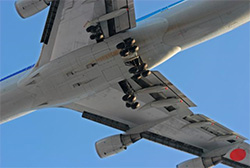By Lily Jin
Sales Director, Aerospace China, Wheelabrator
 The last ten years have been a great success for Aerospace here in China. The sector is going from strength to strength, boosted by the Chinese government’s vision of building its own large passenger jets. The ambition to take on Airbus and Boeing has fuelled its desire to keep improving quality – and the tools needed to achieve it. I can certainly see more and more investment into new, sophisticated machines and processes.
The last ten years have been a great success for Aerospace here in China. The sector is going from strength to strength, boosted by the Chinese government’s vision of building its own large passenger jets. The ambition to take on Airbus and Boeing has fuelled its desire to keep improving quality – and the tools needed to achieve it. I can certainly see more and more investment into new, sophisticated machines and processes.
The organisations in Aerospace that I deal with every day are looking for high-tech equipment that gives them the quality, reliability and process control they need for advanced Aerospace manufacturing. It’s an industry with one of the most highly skilled workforces, who can work in partnership with our local technical support teams.
We cover wheelblast as well as airblast technology for Aerospace applications, but the latter is by far the most common, which is why all our engineers are trained at our dedicated Technology Centre in Charleville, France. It specialises in high-spec airblast technology for Aerospace and high-end Automotive. Together with highly skilled and knowledgeable machine operators at our customer sites, they can commission and run the most sophisticated equipment. The new challenge for the industry lies elsewhere.
The maintenance challenge
Even in a sector as highly developed as Aerospace, China has not embraced equipment maintenance – particularly when it comes to more advanced concepts, such as preventative and proactive maintenance. Yet, machine downtime is just as problematic here as anywhere else. No-one can afford stops in production.
This attitude is not due to a lack of willingness or understanding of operational staff – they know they could prevent downtime through regular, proactive maintenance. So where is the problem?
Perhaps managers have not yet caught up with the idea of investing into the whole life time of a machine, into every working minute. All too often, the view seems to be that investments are about operations today, not tomorrow or into the future. With management less interested in maintenance, production staff’s hands are tied. The result: action is usually only taken the moment the machines actually stop running.
Another reason might be that funding for repairs and maintenance has to be signed off by government agencies, which – even when it happens very quickly – is never fast enough if there’s an urgent need to get production going again.
So how can we as a supplier best support Chinese customers in these situations? I believe it is by being flexible and building trusting relationships. That can mean that for in-warranty machines, we always have the spare parts for customers in stock and can dispatch engineers at very short notice to get equipment up and running again. For out-of-warranty machines, where we would charge for service and maintenance, we go out to fix it without delay, knowing that approval for the cost will come eventually and that we can trust the customer to pay later. It’s a pragmatic approach that takes into account the fact that attitudes don’t change overnight.
If the Chinese Aerospace industry wants a seat at the global table, it will have to learn to take the long-term view, and realise that embracing maintenance enables it to make a giant leap in productivity. Until then, we’re here to help – swiftly and without bureaucracy.

This post was written by
Lily Jin
Sales Director, Aerospace China, Wheelabrator
View biog | View all posts
